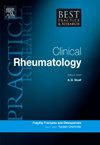Systemic lupus erythematosus and damage: What has changed over the past 20 years?
IF 4.5
2区 医学
Q1 RHEUMATOLOGY
Best Practice & Research in Clinical Rheumatology
Pub Date : 2023-12-01
DOI:10.1016/j.berh.2023.101893
引用次数: 0
Abstract
The young age of onset and chronic/relapsing nature of systemic lupus erythematosus (SLE) make SLE patients prone to develop and accrue organ damage as a result of long-standing disease activity and side effects of treatment. There is a growing interest in objectifying damage and identifying its risk factors. Still, the lack of therapeutic alternatives has led to difficulties in avoiding immunosuppressives particularly corticosteroids, which have been implicated in a large spectrum of organ damage in SLE patients. Moreover, it continues to be very challenging to determine what actually causes damage in different organ-systems.
Cardiovascular disease continues to be one of the leading types of damage in patients with SLE, reported as early as 1976. Since then, many researchers have focused on identifying SLE or treatment-related and traditional risk factors. The same considerations are valid for other conditions, such as the occurrence of metabolic syndrome, osteoporosis, avascular necrosis, susceptibility to infections, etc. On the other hand, diverse risk factors contribute to the development of chronic kidney disease (CKD) in SLE. Most evidence suggests that high initial levels of serum creatinine, hypocomplementemia, nephrotic range proteinuria, concomitant uncontrolled hypertension, Black and Hispanic ancestry, non-adherence to treatment, and biopsy findings such as diffuse proliferative lupus nephritis (LN), a high chronicity index, tubular atrophy, and tubulointerstitial inflammation are risk factors for progression to end stage renal disease (ESRD) in LN. While cardiovascular disease, CKD and infections are leading causes of mortality in patients with SLE, hospitalizations are caused mostly by SLE disease flares and infections. Cognitive impairment and mood disorders are common in SLE but continue to impose a challenge on how to measure, manage and decipher the underlying pathogenesis. Nevertheless, they have a great impact on SLE patients’ health-related quality of life (HRQoL) and social functioning. Also, skin manifestations, such as alopecia and scaring, cataracts, and sicca symptoms result in a significant decrease in HRQoL.
In light of recent developments in SLE treatment, we can expect to enter a period of new-age targeted therapies that will enable us to reduce disease activity and glucocorticoid usage further and positively alter the trajectory of damage development and accrual in SLE.
系统性红斑狼疮和损伤:在过去的20年里发生了什么变化?
系统性红斑狼疮(SLE)的发病年龄小,慢性/复发的性质使得SLE患者由于长期的疾病活动和治疗的副作用,容易发展和积累器官损伤。人们对客观化损害和确定其风险因素的兴趣日益浓厚。尽管如此,缺乏治疗替代方案导致难以避免免疫抑制剂,特别是皮质类固醇,这与SLE患者的大量器官损害有关。此外,确定究竟是什么导致了不同器官系统的损伤仍然是非常具有挑战性的。早在1976年就有报道称,心血管疾病仍然是SLE患者的主要损害类型之一。从那时起,许多研究人员将重点放在识别SLE或治疗相关的传统风险因素上。同样的考虑也适用于其他情况,如代谢综合征、骨质疏松症、缺血性坏死、易感性感染等。另一方面,多种危险因素促进SLE慢性肾脏疾病(CKD)的发展。大多数证据表明,初始高水平的血清肌酐、低补体血症、肾病范围蛋白尿、同时伴有未控制的高血压、黑人和西班牙裔血统、不坚持治疗以及活检结果,如弥漫性增殖性狼疮肾炎(LN)、高慢性指数、小管萎缩和小管间质炎症是LN进展为终末期肾病(ESRD)的危险因素。虽然心血管疾病、慢性肾病和感染是SLE患者死亡的主要原因,但住院主要是由SLE疾病发作和感染引起的。认知障碍和情绪障碍在SLE中很常见,但如何测量、管理和破译潜在的发病机制仍然是一个挑战。然而,它们对SLE患者的健康相关生活质量(HRQoL)和社会功能有很大影响。此外,皮肤表现,如脱发和瘢痕,白内障和干燥症状导致HRQoL显着下降。根据SLE治疗的最新进展,我们可以期待进入一个新时代靶向治疗的时期,这将使我们能够进一步减少疾病活动性和糖皮质激素的使用,并积极改变SLE损伤发展和累积的轨迹。
本文章由计算机程序翻译,如有差异,请以英文原文为准。
求助全文
约1分钟内获得全文
求助全文
来源期刊
CiteScore
9.40
自引率
0.00%
发文量
43
审稿时长
27 days
期刊介绍:
Evidence-based updates of best clinical practice across the spectrum of musculoskeletal conditions.
Best Practice & Research: Clinical Rheumatology keeps the clinician or trainee informed of the latest developments and current recommended practice in the rapidly advancing fields of musculoskeletal conditions and science.
The series provides a continuous update of current clinical practice. It is a topical serial publication that covers the spectrum of musculoskeletal conditions in a 4-year cycle. Each topic-based issue contains around 200 pages of practical, evidence-based review articles, which integrate the results from the latest original research with current clinical practice and thinking to provide a continuous update.
Each issue follows a problem-orientated approach that focuses on the key questions to be addressed, clearly defining what is known and not known. The review articles seek to address the clinical issues of diagnosis, treatment and patient management. Management is described in practical terms so that it can be applied to the individual patient. The serial is aimed at the physician in both practice and training.

 求助内容:
求助内容: 应助结果提醒方式:
应助结果提醒方式:


